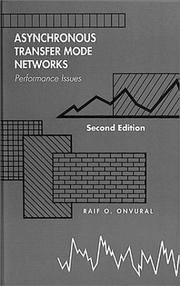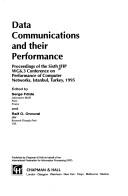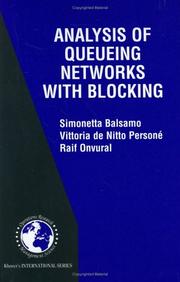| Listing 1 - 4 of 4 |
Sort by
|

ISBN: 0890068046 Year: 1995 Publisher: Boston (Mass.) : Artech house,
Abstract | Keywords | Export | Availability | Bookmark
 Loading...
Loading...Choose an application
- Reference Manager
- EndNote
- RefWorks (Direct export to RefWorks)
Asynchronous transfer mode. --- Integrated services digital networks. --- Asynchronous transfer mode --- Integrated services digital networks --- 004.72 --- ATM asynchronous transfer mode --- BISDN breedband-ISDN --- datacommunicatie --- elektrotechniek --- ISDN integrated service digital network --- netwerkbeheer --- protocols --- routing --- ISDN (Digital networks) --- Data transmission systems --- Digital communications --- ATM (Data transmission) --- Broadband communication systems --- Packet switching (Data transmission) --- Netwerkarchitectuur

ISBN: 0890068712 Year: 1997 Publisher: Boston (Mass.) : Artech house,
Abstract | Keywords | Export | Availability | Bookmark
 Loading...
Loading...Choose an application
- Reference Manager
- EndNote
- RefWorks (Direct export to RefWorks)

ISBN: 0412732505 Year: 1996 Publisher: London : Chapman and Hall,
Abstract | Keywords | Export | Availability | Bookmark
 Loading...
Loading...Choose an application
- Reference Manager
- EndNote
- RefWorks (Direct export to RefWorks)

ISBN: 0792379969 1441950141 1475733453 9780792379966 Year: 2001 Volume: 31 Publisher: Boston (Mass.) : Kluwer academic,
Abstract | Keywords | Export | Availability | Bookmark
 Loading...
Loading...Choose an application
- Reference Manager
- EndNote
- RefWorks (Direct export to RefWorks)
Queueing network models have been widely applied as a powerful tool for modelling, performance evaluation, and prediction of discrete flow systems, such as computer systems, communication networks, production lines, and manufacturing systems. Queueing network models with finite capacity queues and blocking have been introduced and applied as even more realistic models of systems with finite capacity resources and with population constraints. In recent years, research in this field has grown rapidly. Analysis of Queueing Networks with Blocking introduces queueing network models with finite capacity and various types of blocking mechanisms. It gives a comprehensive definition of the analytical model underlying these blocking queueing networks. It surveys exact and approximate analytical solution methods and algorithms and their relevant properties. It also presents various application examples of queueing networks to model computer systems and communication networks. This book is organized in three parts. Part I introduces queueing networks with blocking and various application examples. Part II deals with exact and approximate analysis of queueing networks with blocking and the condition under which the various techniques can be applied. Part III presents a review of various properties of networks with blocking, describing several equivalence properties both between networks with and without blocking and between different blocking types. Approximate solution methods for the buffer allocation problem are presented.
Planning (firm) --- Computer networks --- Queuing theory --- Blocking sets --- Algorithms --- Algorithms. --- Blocking sets. --- Computer networks. --- Queuing theory. --- Operations research. --- Decision making. --- Computer communication systems. --- Probabilities. --- Electrical engineering. --- Operations Research/Decision Theory. --- Computer Communication Networks. --- Probability Theory and Stochastic Processes. --- Electrical Engineering. --- Electric engineering --- Engineering --- Probability --- Statistical inference --- Combinations --- Mathematics --- Chance --- Least squares --- Mathematical statistics --- Risk --- Communication systems, Computer --- Computer communication systems --- Data networks, Computer --- ECNs (Electronic communication networks) --- Electronic communication networks --- Networks, Computer --- Teleprocessing networks --- Data transmission systems --- Digital communications --- Electronic systems --- Information networks --- Telecommunication --- Cyberinfrastructure --- Electronic data processing --- Network computers --- Deciding --- Decision (Psychology) --- Decision analysis --- Decision processes --- Making decisions --- Management --- Management decisions --- Choice (Psychology) --- Problem solving --- Operational analysis --- Operational research --- Industrial engineering --- Management science --- Research --- System theory --- Distributed processing --- Decision making
| Listing 1 - 4 of 4 |
Sort by
|

 Search
Search Feedback
Feedback About UniCat
About UniCat  Help
Help News
News